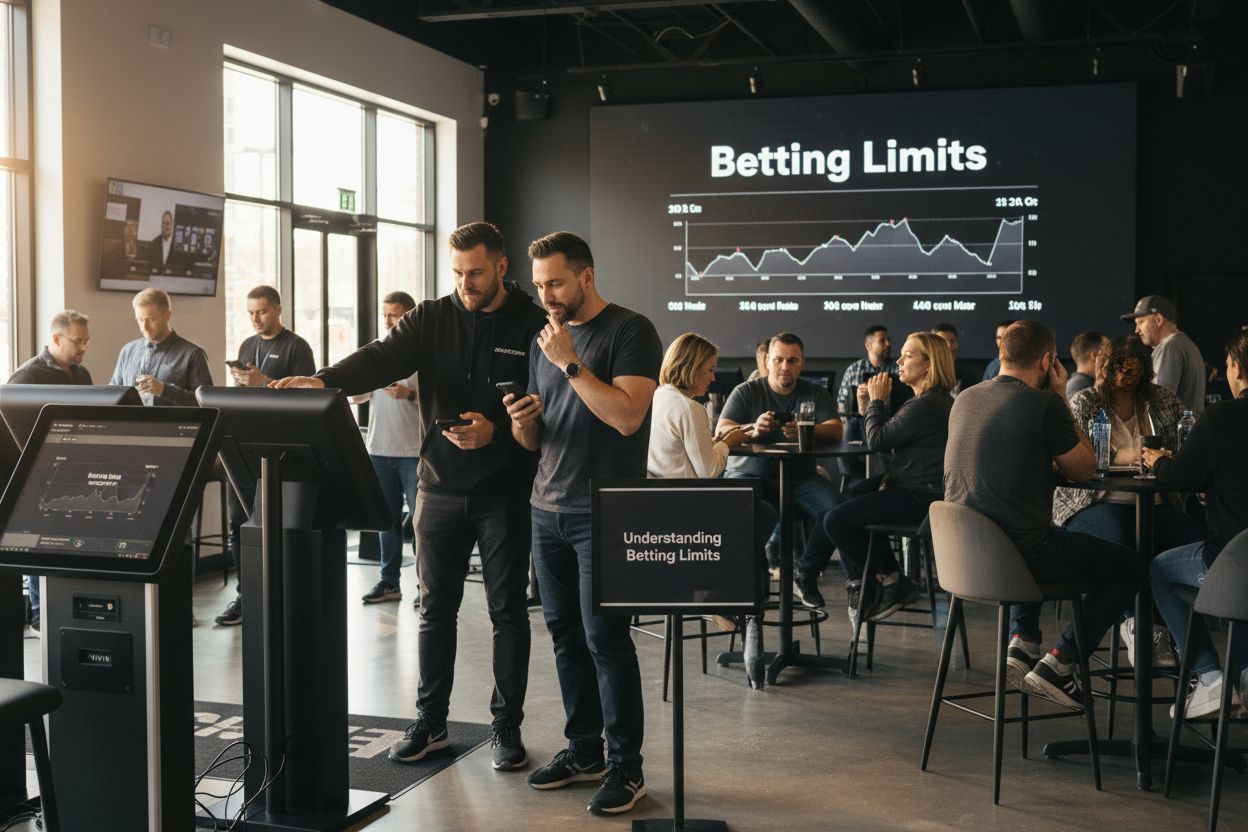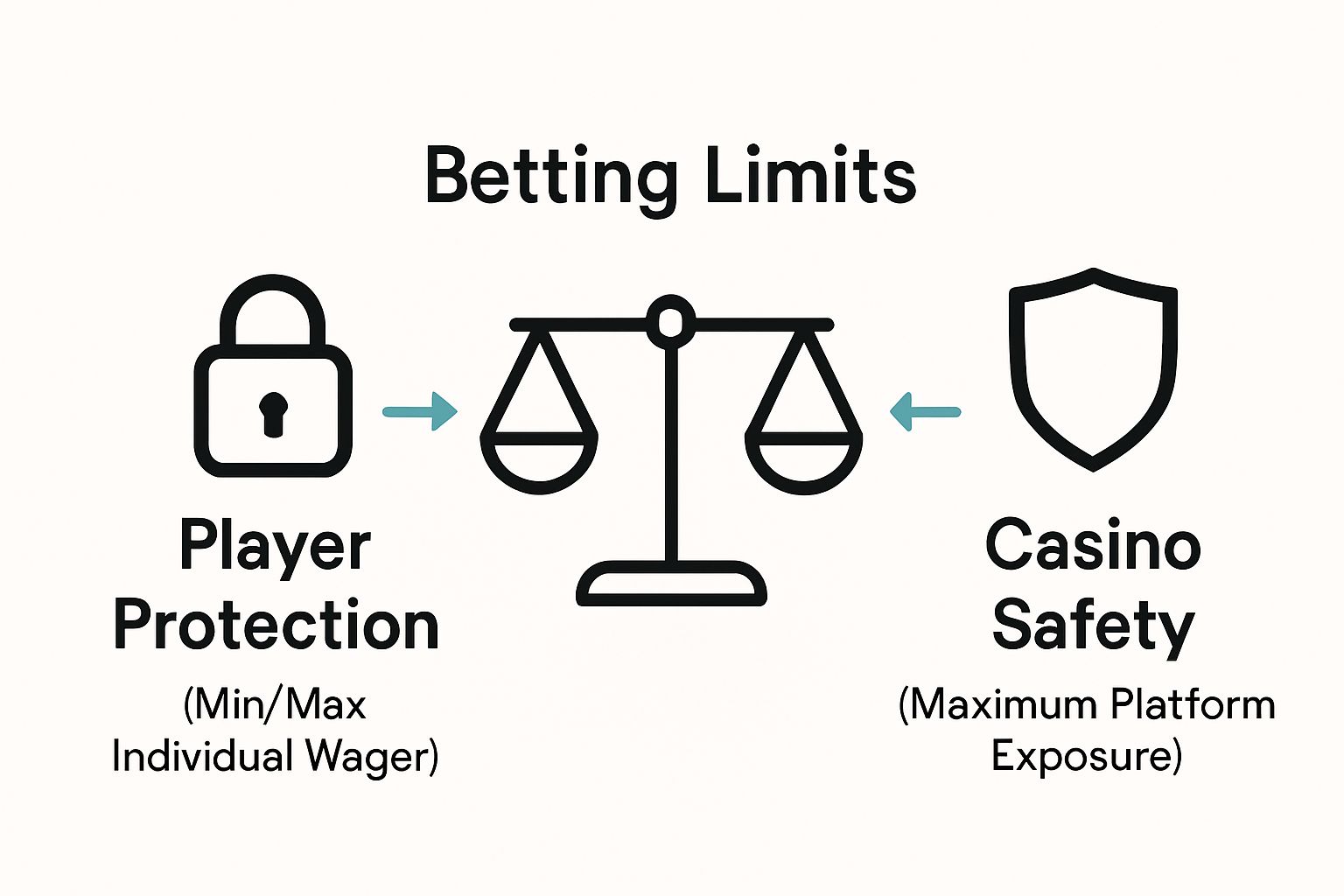
Every gambler has faced the gut check of how much to risk on a single bet and casinos set boundaries for a reason. Some roulette tables let you wager as little as 50 cents, while high-roller rooms might accept bets over $10,000 per hand. That sounds like freedom and thrill all packed into one spin or deal. Still, the most surprising move is that these betting limits are really there to protect everyone at the table, not just to keep you in check.
Table of Contents
- What Are Betting Limits And Their Types?
- Why Betting Limits Are Important For Gamblers
- How Betting Limits Impact Casinos And Sportsbooks
- Key Factors Influencing Betting Limits
- Real-World Examples Of Betting Limits In Action
Quick Summary
| Takeaway | Explanation |
|---|---|
| Betting limits define financial boundaries. | These limits control the maximum and minimum amounts players can wager, ensuring responsible gambling. |
| Types of betting limits vary by platform. | Common types include minimum, maximum, daily, and deposit limits, impacting player strategies. |
| Limits protect players from financial harm. | Betting limits help prevent impulsive decisions, reducing the risk of significant monetary losses. |
| Regulatory compliance is crucial for platforms. | Limits are essential for casinos and sportsbooks to maintain licenses and operational security. |
| Dynamic limits adapt to player behavior. | Gambling platforms use algorithms to adjust limits in real-time based on risk assessments and player activity. |
What Are Betting Limits and Their Types?
Betting limits represent predefined financial boundaries that control the maximum and minimum amounts you can wager during gambling activities. These constraints are fundamental mechanisms designed to protect both players and gambling platforms from excessive financial risks.
Understanding Basic Betting Limit Structures
Betting limits come in multiple variations, each serving specific purposes within sports betting and casino gaming environments. Our comprehensive sports betting guide breaks down these critical financial parameters that determine how much money can be staked on different games and events.
The primary types of betting limits include:
- Minimum Bet Limit: The smallest amount a player can wager on a single bet
- Maximum Bet Limit: The highest monetary amount permitted for a single wager
- Daily Limit: Total maximum betting amount allowed within a 24-hour period
- Deposit Limit: Maximum funds a player can add to their betting account
Strategic Importance of Betting Limits
Betting limits serve crucial functions beyond simple monetary restrictions. According to responsible gambling research from the National Council on Problem Gambling, these limits play a significant role in:
- Preventing uncontrolled gambling behavior
- Protecting players from substantial financial losses
- Ensuring fair and regulated gambling experiences
- Maintaining financial sustainability for both players and platforms
By establishing clear boundaries, betting limits create a structured environment that balances entertainment with financial prudence.
 Players can enjoy gambling activities while having predefined safeguards that mitigate potential risks of excessive spending.
Players can enjoy gambling activities while having predefined safeguards that mitigate potential risks of excessive spending.
Each gambling platform may implement slightly different limit structures, so understanding the specific parameters of your chosen platform becomes essential for responsible and strategic betting.
To illustrate the variety of betting limit types, the following table summarizes their names, definitions, and example values as discussed in the article.
| Limit Type | Definition | Example Value |
|---|---|---|
| Minimum Bet Limit | The smallest amount a player can wager on a single bet | $0.50 (slot spin) / $5 (roulette) |
| Maximum Bet Limit | The highest monetary amount permitted for a single wager | $1,000 (roulette) / $10,000 (VIP) |
| Daily Limit | Total maximum betting amount allowed within 24 hours | $5,000 per day |
| Deposit Limit | Maximum funds a player can add to their betting account | $2,500 per 24 hours |
Why Betting Limits Are Important for Gamblers
Betting limits are not just arbitrary financial restrictions but sophisticated risk management tools that protect both players and gambling platforms from potential financial harm. These strategic constraints transform gambling from an uncontrolled activity into a responsible and sustainable form of entertainment.
Financial Protection and Risk Management
The primary purpose of betting limits is to provide a robust financial safety net. Our guide on managing your sports betting budget explains that these limits prevent players from making impulsive decisions that could lead to substantial monetary losses. By establishing clear boundaries, gamblers can:
- Control their total spending
- Prevent catastrophic financial damage
- Maintain a disciplined approach to gambling
- Create predictable entertainment expenses
Psychological and Behavioral Safeguards
According to research from the Harvard Medical School’s Addiction Research Center, betting limits serve critical psychological functions. They act as external regulators that interrupt potential addictive behavioral patterns. These limits create psychological friction that:
- Interrupt compulsive gambling cycles
- Provide natural pause points for decision making
- Reduce the neurological reward response associated with continuous betting
- Help individuals maintain emotional and financial equilibrium
Promoting Responsible Gaming Practices
Betting limits are fundamental to responsible gaming philosophies. They transform gambling from a high-risk activity into a controlled form of entertainment. By implementing strategic financial boundaries, platforms demonstrate their commitment to player welfare and sustainable gaming practices.
The table below compares how betting limits are applied across different types of gambling activities as described in the article.
| Game / Platform | Typical Minimum Bet | Typical Maximum Bet | Notes |
|---|---|---|---|
| Slot Machines | $0.50 | $500 per spin | Strict per-spin limits |
| Roulette Table | $5 | $1,000 per bet | Table minimum and maximum vary |
| Blackjack Table | Varies | Varies | May change based on player history |
| High-Roller Room | $100 | $10,000+ per hand | Elevated limits for high-stakes players |
| Football Betting | Varies | $500–$5,000 per event | Higher limits for major events |
| Basketball Betting | Varies | $250–$2,000 per event | Generally lower than football |
 These limits ensure that gambling remains an enjoyable activity without risking personal financial stability, making them an essential component of ethical gaming environments.
These limits ensure that gambling remains an enjoyable activity without risking personal financial stability, making them an essential component of ethical gaming environments.
How Betting Limits Impact Casinos and Sportsbooks
Betting limits represent a sophisticated risk management strategy that fundamentally shapes operational dynamics for gambling platforms. These financial constraints are not merely protective measures for players but critical tools that help casinos and sportsbooks maintain economic stability and regulatory compliance.
Financial Risk Mitigation Strategies
Exploring the nuanced world of sports betting platforms reveals how betting limits function as sophisticated financial firewalls. These strategic boundaries protect gambling institutions from potentially catastrophic monetary risks by:
- Preventing massive single-event losses
- Controlling overall financial exposure
- Creating predictable revenue streams
- Minimizing vulnerability to professional gamblers
Regulatory Compliance and Operational Security
According to financial regulatory research from the Gaming Compliance Institute, betting limits are not optional recommendations but essential requirements for maintaining operational licenses. They serve multiple critical functions:
- Demonstrating commitment to responsible gaming practices
- Providing transparent financial tracking mechanisms
- Ensuring alignment with local gambling regulations
- Creating audit-friendly financial documentation
Strategic Business Management
Betting limits represent more than risk control they are sophisticated business management tools. By carefully calibrating maximum and minimum bet amounts, casinos and sportsbooks can optimize their economic models, balance potential winnings against potential losses, and create environments that remain attractive to players while protecting institutional financial health. These limits allow gambling platforms to offer competitive experiences without exposing themselves to unmanageable financial risks, striking a delicate balance between player engagement and institutional stability.
Key Factors Influencing Betting Limits
Betting limits are dynamic parameters that reflect complex interactions between player behavior, platform strategy, and regulatory requirements. Understanding the nuanced factors that shape these limits provides insight into the sophisticated risk management approach of modern gambling platforms.
Player Risk Profile and Behavioral Analysis
Exploring the psychological dimensions of sports betting reveals that individual player characteristics significantly impact betting limit configurations. Gambling platforms assess multiple personal risk indicators to determine appropriate financial boundaries:
- Previous betting history and transaction patterns
- Individual win-loss ratios
- Frequency and consistency of gambling activity
- Historical financial stability and deposit behaviors
Regulatory and Jurisdictional Constraints
According to international gambling regulatory research, betting limits are fundamentally shaped by legal frameworks that vary across different jurisdictions. These regulatory environments impose critical constraints that directly influence limit structures:
- Local gambling legislation requirements
- Minimum and maximum stake regulations
- Responsible gaming mandates
- Consumer protection guidelines
Platform-Specific Risk Management Strategies
Betting limits represent sophisticated computational models that balance multiple strategic considerations. Gambling platforms develop intricate algorithms that dynamically adjust limits based on real-time risk assessments. These computational approaches consider complex variables such as game type, betting volume, potential payout risks, and overall platform financial exposure. By continuously monitoring and recalibrating these limits, platforms maintain a delicate equilibrium between player engagement and institutional financial security.
Real-World Examples of Betting Limits in Action
Betting limits manifest differently across various gambling platforms and game types, demonstrating the complexity of risk management strategies. Understanding these practical applications provides valuable insights into how betting constraints operate in real-world scenarios.
Sports Betting Limit Scenarios
Smart bettors understand the importance of responsible gaming practices which are exemplified through specific betting limit implementations. In professional sports betting, platforms typically establish nuanced limit structures:
- Football matches might allow maximum single bets between $500 and $5,000
- Basketball games could have lower limits around $250 to $2,000
- Championship or high-profile events often feature higher maximum bet thresholds
- Live betting scenarios frequently involve more dynamic and rapidly adjusting limits
Casino Game Betting Limit Variations
According to gambling industry analytics from the International Gaming Research Center, different casino games demonstrate unique betting limit approaches:
- Slot machines often have strict per-spin limits ranging from $0.50 to $500
- Roulette tables might implement minimum bets of $5 and maximum bets of $1,000
- Blackjack tables typically feature more complex limit structures based on player history
- High-roller rooms can have substantially elevated betting limits exceeding $10,000 per hand
Dynamic Limit Adjustment Mechanisms
Modern gambling platforms utilize sophisticated algorithms to dynamically adjust betting limits. These computational systems continuously assess multiple risk factors, including player behavior, game dynamics, and real-time financial exposure. By implementing responsive limit mechanisms, platforms can instantaneously modify maximum and minimum bet thresholds, ensuring both player protection and institutional financial stability. This adaptive approach represents a cutting-edge strategy in managing the inherent uncertainties of gambling platforms.
Ready to Take Control of Your Betting Experience?
Understanding betting limits is the first step to smarter and safer wagering. If you are looking for a platform that not only explains betting limits but also empowers you with real-time tools and responsible gaming support, Betco AG is designed for you. Dive even deeper with our Responsible Gambling and Security resources to discover how setting clear deposit and wager limits protects your fun and your finances every time you play.

Discover a complete digital ecosystem that puts your safety and enjoyment first. Join Betco AG today and explore an industry-leading variety of live sports betting, casino games, and user-focused features for every level of player. Take the first step toward confident play by visiting Betco AG now. Want practical strategies and expert tips for applying betting limits? Browse our Sports Betting Tips, Strategies & Insights section and start betting smarter today.
Frequently Asked Questions
What are betting limits?
Betting limits are predefined financial boundaries that establish the maximum and minimum amounts players can wager during gambling activities. They are designed to protect players and gambling platforms from excessive financial risks.
What types of betting limits are commonly implemented?
Common types of betting limits include minimum bet limits, maximum bet limits, daily limits, and deposit limits. Each limit serves a unique purpose in controlling betting behavior and ensuring responsible gambling practices.
How do betting limits promote responsible gaming?
Betting limits serve as financial safety nets by preventing uncontrolled gambling behavior, protecting players from substantial losses, and ensuring a more regulated and fair gambling experience.
How do gambling platforms determine betting limits?
Gambling platforms determine betting limits based on several factors, including player risk profiles, behavioral analysis, and regulatory requirements. They may also implement dynamic algorithms to adjust limits in real time based on various risk assessments.
